Early Temples in India
During the early part of the Vedic era, there is no clear mention of temples. Instead, worship and rituals were conducted in front of the holy fire, known as "yajnas". However, as the Vedas progressed, idol worship alongside the ceremonial fire began to be practiced, with these idols being housed in basic dwellings. The initial temples were likely made of earth mounds and were later replaced by brick structures with grass roofs.
Before distinctive temple styles emerged in India, there were three types of early temples: the Sandhara type without Pradikshinapatha, the Nirandhara type with Pradakshinapatha, and the Sarvatobhadra type, which could be accessed from all sides. Some of the notable temple sites from this era include Deogarh in Uttar Pradesh, Eran, Nachna-Kuthara, and Udaygiri near Vidisha in Madhya Pradesh. These temples were simple structures, comprising a veranda, a hall, and a shrine at the rear.
Basic form of Hindu temple
The fundamental elements of a Hindu temple include:
- The Sanctum (Garbhagriha), originally a small cubicle with a single entrance that later grew in size. This chamber houses the main icon, which is the focus of much ritual attention.
- The entrance to the temple, which can be a portico or colonnaded hall that accommodates a large number of worshippers and is known as a mandapa.
- Freestanding temples often have a spire that resembles a mountain, such as a curving shikhar in North India or a pyramidal tower, called a vimana, in South India.
- The Vahan, which is the mount or vehicle of the temple's main deity, along with a standard pillar or dhvaj placed axially before the sanctum.
- In India, there are two broad orders of temples: Nagara in the north and Dravida in the south.
- Some experts also recognize the Vesara style of temples, created by the selective mixing of the Nagara and Dravida orders, as a distinct style of temple architecture.
The iconography of Indian temples falls under the branch of art history known as iconography. It involves the identification of images based on specific symbols and mythologies associated with them. Each region and period in India produced its unique style of images with regional variations in iconography.
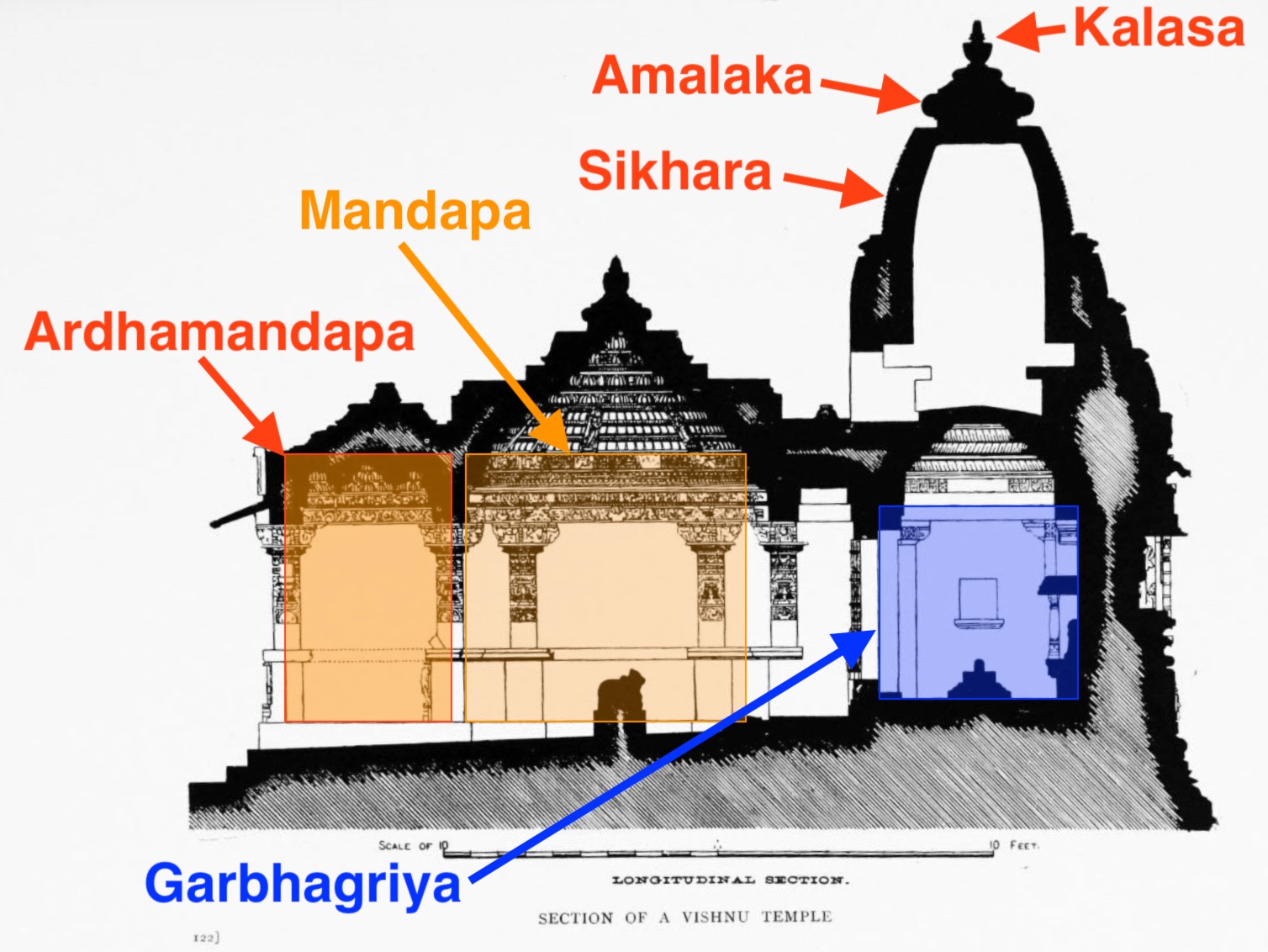
The placement of an image in a temple is carefully planned. For example, river goddesses (Ganga and Yamuna) are typically found at the entrance of a Garbhagriha in a Nagara temple, while Dvarapalas (doorkeepers) are commonly found on the gateways or gopurams of Dravida temples. Additionally, mithunas (erotic images), navagrahas (the nine auspicious planets), and yakshas are often placed at entrances to guard them.
Subsidiary shrines surrounding the main temple are dedicated to the family or incarnations of the main deity. Finally, various decorative elements, such as gavaksha, vyala/yali, kalpa-lata, amalaka, kalasha, etc., are used in specific ways and locations in a temple.
Dravida style of temple architecture
The Pallavas, who ruled over parts of Karnataka, Andhra Pradesh, and northern Tamil Nadu until the ninth century, pioneered the Dravidian style of temple architecture in South India. Although they were mostly Shaivite, several Vaishnava shrines also survived from their reign. The early buildings are usually attributed to Mahendravarman I, a contemporary of the Chalukyan king, Pulakesin II of Karnataka. Narasimhavarman I, also known as Mamalla, who ascended the Pallava throne around 640 CE, is celebrated for his architectural works.
- The main features of Dravidian temple architecture include the temple being enclosed within a compound wall and having an entrance gateway in the front wall known as a Gopuram.
- The main temple tower, called vimana in Tamil Nadu, is shaped like a stepped pyramid that rises up geometrically instead of the curving shikhara found in North Indian temples.
- The crowning element at the top of the temple, usually shaped like a small stupika or an octagonal cupola, is called shikhara in North Indian temples, equivalent to the amalak and kalasha.
- Fierce Dvarapalas adorn the entrance to garbhagriha, guarding the temple.
- It is common to find a large water reservoir, or a temple tank, enclosed within the complex.
- Subsidiary shrines are either incorporated within the main temple tower or located as separate small shrines beside the main temple.
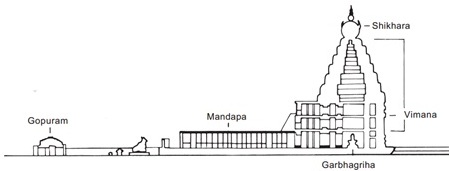
The Kailashnath temple at Ellora is a famous example of a temple built in complete Dravidian style.
Dravidian temples can be classified into five different shapes: square, rectangular, elliptical, circular, and octagonal. However, several different shapes may be combined in specific periods and places to create a unique style.
Famous Dravidian temples in India include the magnificent Shiva temple of Thanjavur, called the Rajarajeswara or Brihadeshwara temple, built in the Dravidian style and completed around 1009 by Rajaraja Chola. It is the largest and tallest of all Indian temples. Other famous Dravidian temples in the south include the Annamalaiyar Temple in Tiruvannamalai, Tamil Nadu, Meenakshi temple, Tamil Nadu, Airavatesvara temple, etc.
The Pallavas created beautiful monuments in the 7th century AD. Mahendravarman and his son Narasimhavarman were great patrons of art and architecture, and their contribution to rock-cut architecture will be discussed elsewhere. The Shore temple at Mahabalipuram was built later, probably in the reign of Narasimhavarman II, also known as Rajasimha, and has shrines dedicated to Shiva and Vishnu.
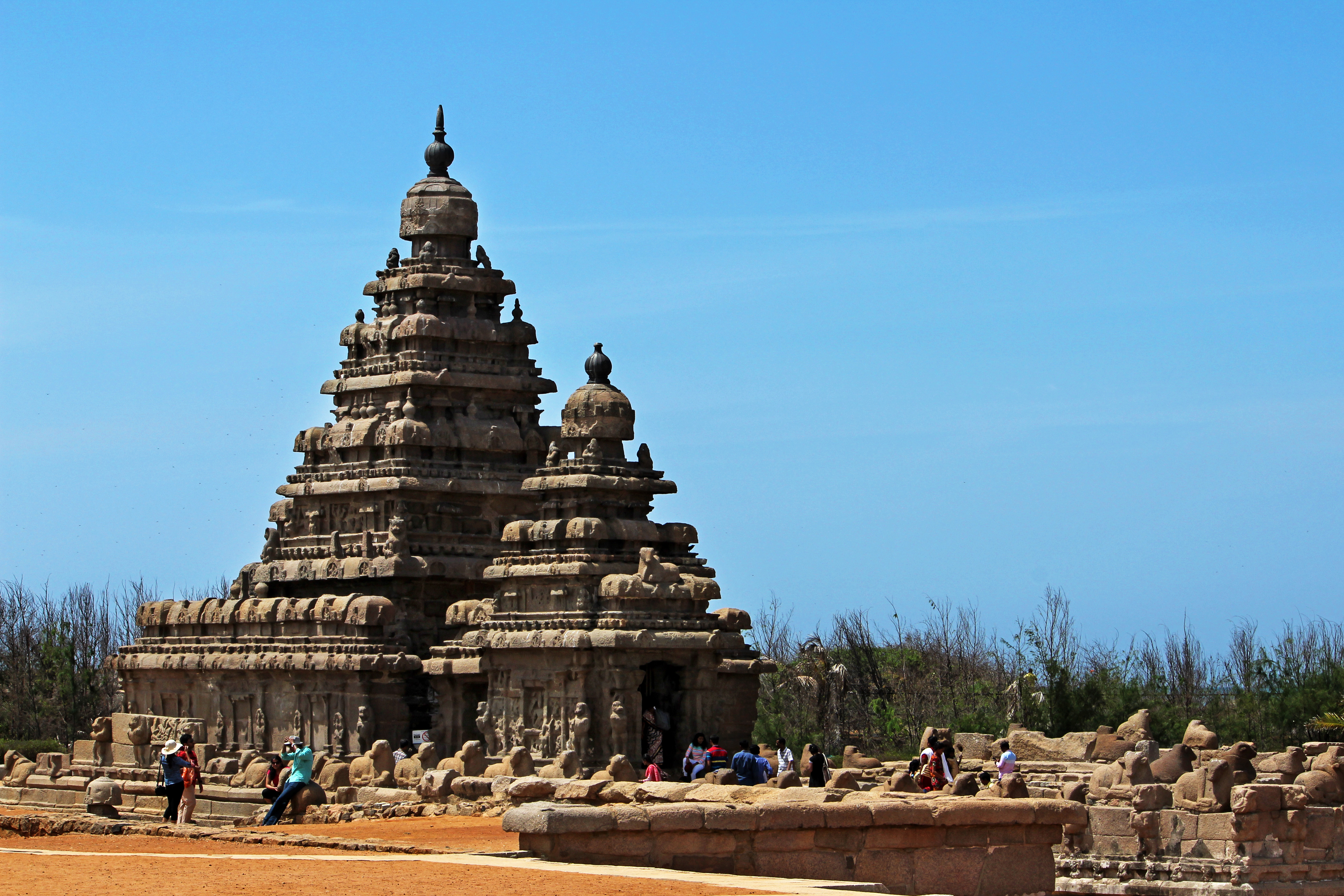
The Cholas perfected the Dravidian temple style inherited from the Pallavas. During this time, the architecture style became more elaborate by moving away from the early cave temples of the Pallavas. Stone became the predominant material for temple construction, and Gopurams became more prominent, decorated with carvings representing various Puranas. The Vimanas attained greater grandeur during the Chola period. The temple tower of Brihadeshwara temple is 66 meters tall, and greater emphasis was given to the use of sculptures in temple construction.
Nagara Style or North India Temple Style
The Nagara style of temple architecture, popular in northern India, is characterized by an entire temple built on a stone platform with steps leading up to it. Unlike other styles, Nagara temples typically lack elaborate boundary walls or gateways. The garbhagriha, or inner sanctum, is always located directly under the tallest tower, and the shape of the shikhara (tower) can vary among subdivisions of Nagara temples.
Another defining feature of Nagara style is the Amalaka or Kalash installed on the Shikhara. Examples of this style can be seen in the Kandariya Mahadev Temple in Madhya Pradesh, as well as the Sun temple in Konark, the Sun temple at Modhera in Gujarat, and the Ossian temple in Gujarat.
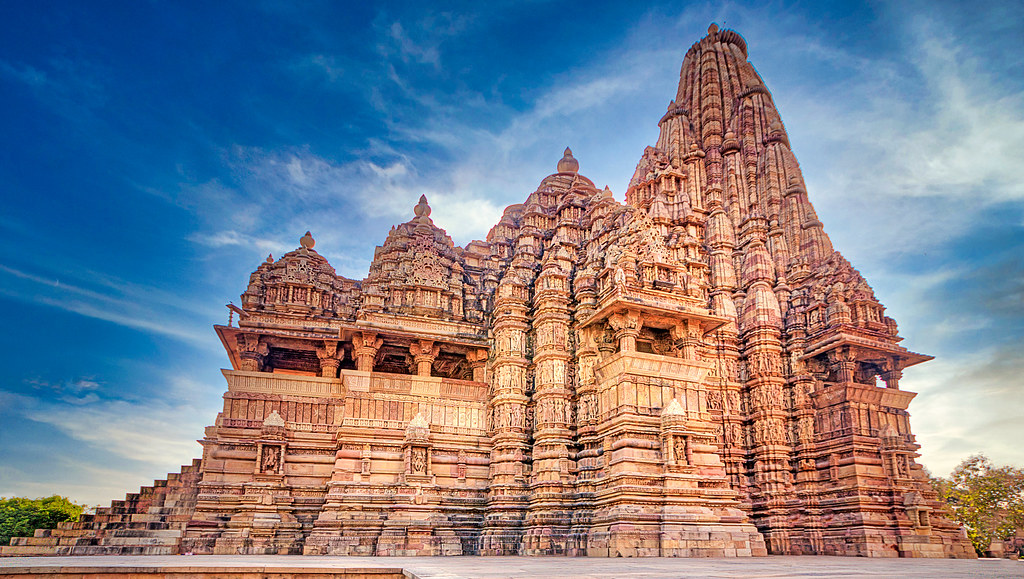
The Nagara style of temple architecture can be classified based on the style of Shikhara, which is the tower-like structure on the top of the temple.
Rekha-Prasad or Latina style features a simple Shikara with a square base and inward curving walls that have a pointed top. Examples of this style include the Sun Temple at Markhera in Madhya Pradesh and the Sri Jagannath Temple in Odisha.
Shekari style is a variation of Latina, featuring a main Rekha-Prasad Shikara and one or more rows of smaller steeples on both sides of the central spire. The Khajuraho Kandariya Mahadev Temple is an example of this style.
Bhumija style evolved from the Latina style and was developed in Malwa under the Paramara dynasty. It features a flat upward tapering projection comprising of a central Latina spire and miniature spires on the quadrant formed by the tapering tower. Examples of this style include the Udayeshwar Temple in Madhya Pradesh.
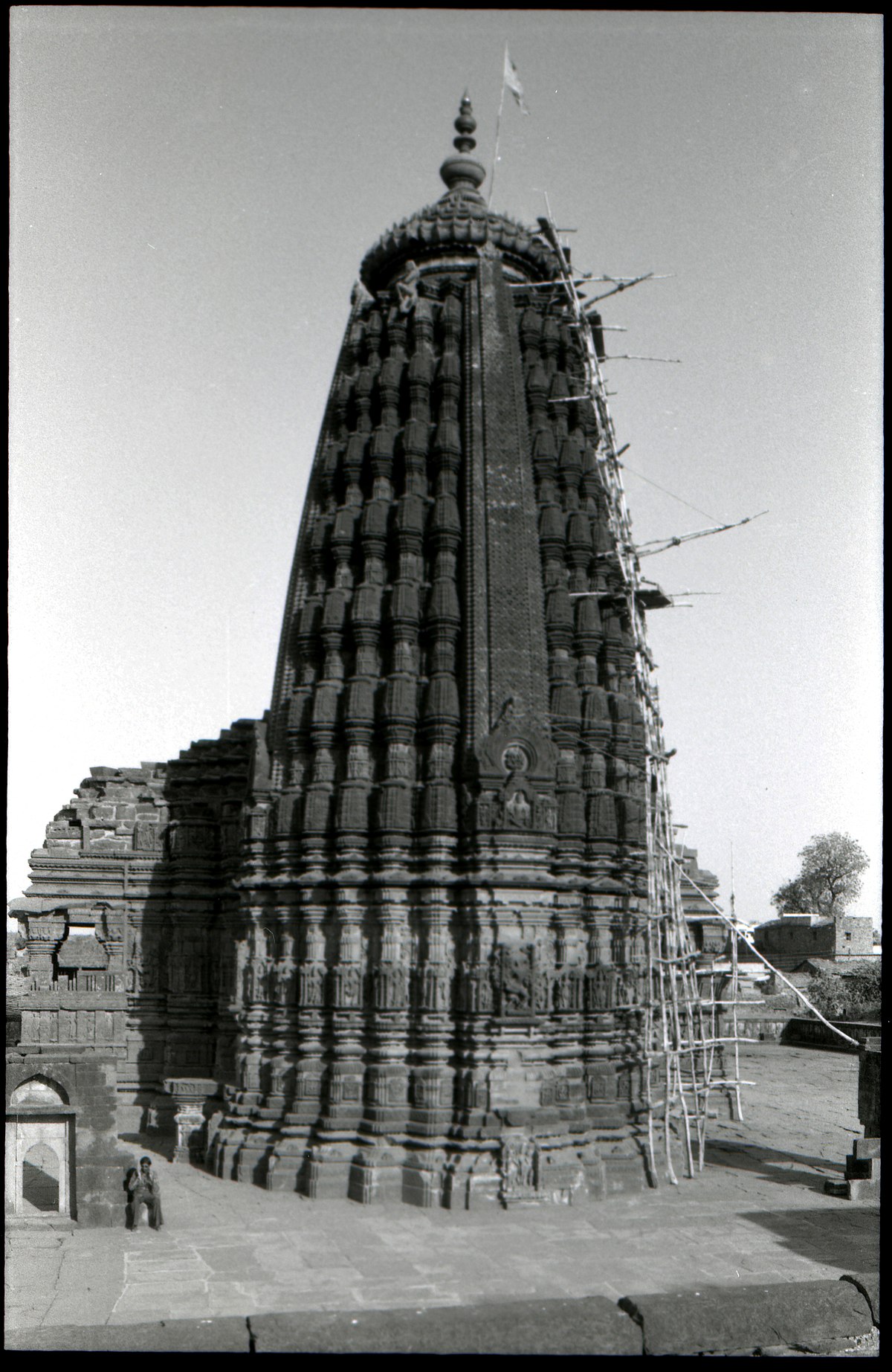
Valabhi style temples are rectangular in shape and feature barrel-vaulted roofs. They are also known as wagon vaulted buildings/structures. The Teli Ka Mandir, a 9th Century temple at Gwalior, is an example of this style.
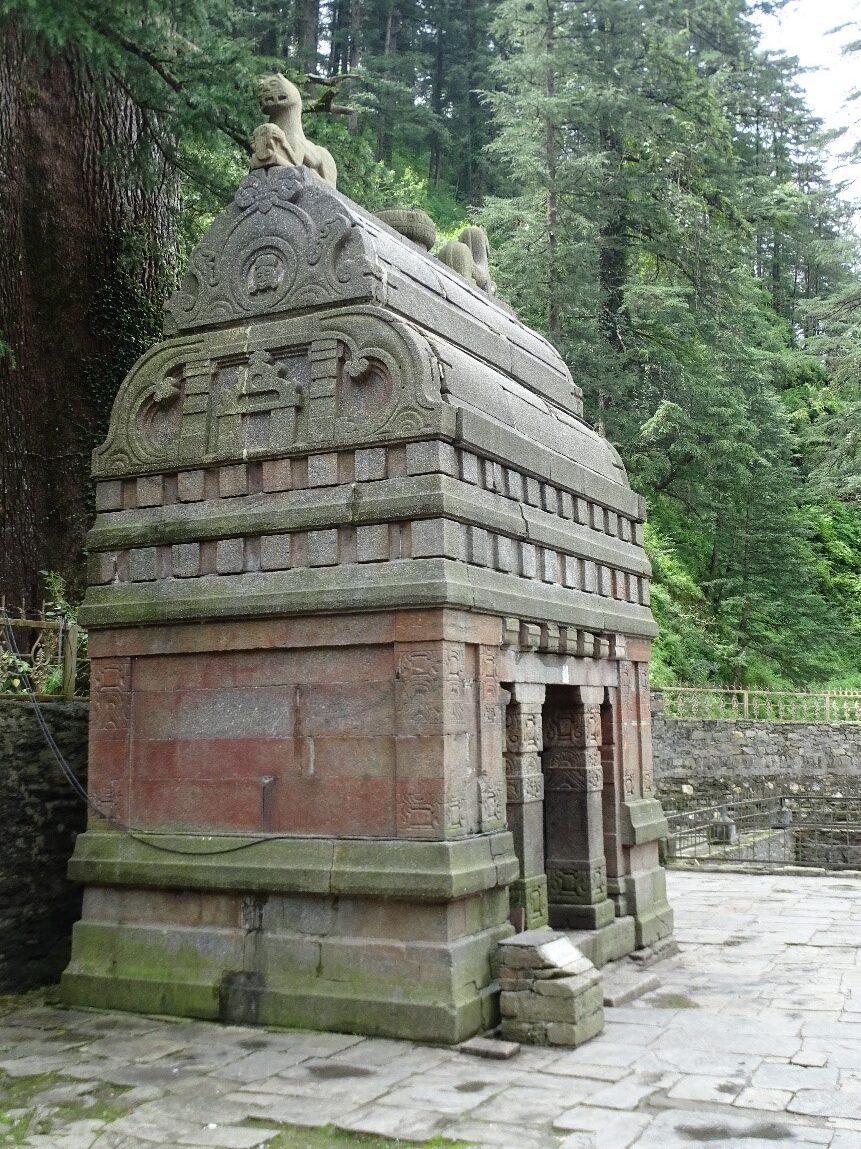
Phamsana style features shorter but broader structures comprising of roofs with numerous slabs that rise upwards in a gentle slope on a straight incline like a pyramid meeting at a single point over the mid-point of the building. The Jagmohan of Konark Temple is constructed in the Phamsana style.
Different Sub-schools of Nagara Style of Temple Architecture
Odisha School - The Shikara (Deul) of this school rises vertically before curving inwards at the top, with a square base and circular upper reaches. These temples are known for their intricate exterior carvings and often have boundary walls, unlike Nagara temples of the north.
Chandel School - These temples are conceived as a single unit and feature Shikaras that curve from bottom to top. Miniature Shikaras rise from the central tower, and towers that gradually rise up to the main tower cap both the porticos and halls.
Solanki School - Similar to the Chandel School, but with carved ceilings that resemble a true dome. These temples are known for their intricate decorative motifs, with carvings present on both the inner and outer sides of the walls, except for the central shrine.
Famous Nagara temples in various regions of India
Central India
Central India is home to some of the oldest surviving Nagara style structural temples, which date back to the Gupta Period and are located in Madhya Pradesh. These temples are relatively simple, with each having four pillars that support a small mandapa or porch-like extension leading to the garbhagriha, which is the main shrine. One classic example of a late Gupta Period temple is the Deogarh temple, located in the Lalitpur District of Uttar Pradesh. This temple, built in the early sixth century CE, is in the panchayatana style of architecture, with the main shrine on a rectangular plinth and four smaller subsidiary shrines at the four corners. The presence of a curvilinear shikhara of the latina or rekha-prasada type confirms that this is an early example of a classic Nagara style of temple.
The Lakshmana temple in Khajuraho, dedicated to Vishnu and built in 954 by the Chandela king Dhanga, is a Nagara style temple located on a high platform accessible by stairs. There are four smaller temples in the corners, and all the towers or shikharas rise high, upward in a curved pyramidal fashion, with a horizontal fluted disc called an amalak topped with a kalash or vase. These crowning elements are characteristic of Nagara temples of this period.
The Kandariya Mahadeo temple at Khajuraho is the epitome of Nagara style temple architecture in Central India. In addition to its architectural features, Khajuraho's temples are also famous for their extensive erotic sculptures, which depict the importance of erotic expression in human experience as part of a larger cosmic whole that includes spiritual pursuit.
West India
The Nagara style temples of West India can be found in the states of Gujarat and Rajasthan. One example of this style is the Sun Temple at Modhera, which was constructed by Raja Bhimdev I of the Solanki Dynasty in 1026 and dates back to the early eleventh century. This temple exhibits the influence of Gujarat's woodcarving tradition in its design and decorations.
East India
Eastern India is home to several Nagara-style temples found in the North-East, Bengal, and Odisha regions. In Bengal, until the seventh century, terracotta was the main medium of construction, and plaques depicting Buddhist and Hindu deities were molded in this material. In Assam, evidence of Gupta style influence can be seen in a sixth-century sculpted door frame from DaParvatia and some stray sculptures from Rangagora Tea Estate near Tinsukia. The Ahom style, a result of the migration of the Tais from Upper Burma mixing with the dominant Pala style of Bengal, is seen in and around Guwahati, with Kamakhya temple, a Shakti Peeth, built in the seventeenth century.
In Bengal, the Pala style is expressed in the temples and is exemplified in the Siddheshvara Mahadeva temple in Barakar, Burdwan District, which has a tall curving shikhara topped by a large amalaka, much like contemporary temples in Odisha. The Nagara temples in Odisha have a distinct sub-style, with their shikhara, called deul, being vertical until the top, where it sharply curves inward.
Konark is home to the magnificent ruins of the Surya or Sun temple built in stone around 1240, with a colossal shikhara said to have reached 70m. Other well-known Nagara temples in this region include the Muktesvara temple, Rajarani temple, Lingaraja temple, among others.
The Hill States of India
A distinctive architectural style emerged in the hill regions of Kumaon, Garhwal, Himachal and Kashmir, influenced by both the Gupta and post-Gupta traditions imported from Sarnath, Mathura, Gujarat and Bengal. This resulted in the intermingling of Buddhist and Hindu traditions, which spread throughout the hills. Additionally, the hills had their own tradition of wooden buildings with pitched roofs. Consequently, in several places in the hills, the main garbhagriha and shikhara are built in a rekha-prasada or Latina style, while the mandapa is of an older form of wooden architecture. Sometimes, the temple takes on a pagoda shape. The Jageshwar and Champavat temples in Kumaon exemplify the Nagara architecture of the region. Kashmir's proximity to important Gandhara sites also contributed to this unique form of architecture.
Vesara style of temple architecture
The Vesara style of temple architecture is a fusion of Nagara and Dravidian styles. Its name is believed to have originated from the Sanskrit word "vishra" meaning "an area to take a long walk". Many historians agree that the Vesara style was developed in present-day Karnataka.
This style was initiated by the Chalukyas of Badami (500-753 AD) who constructed temples that combined the Nagara and Dravida styles. It was further developed and refined by the Rashtrakutas of Manyakheta (750-983 AD) in Ellora, Chalukyas of Kalyani (983-1195 AD) in Lakkundi, Dambal, Gadag and other places, and reached its peak during the Hoysala period (1000-1330 AD).
The Hoysala temples at Belur, Halebidu, and Somnathpura are outstanding examples of this style.
Unique features of Vesara style of temple architecture
Ornamentation is a defining feature of Chalukyan temples, exhibiting indigenous qualities in the way they adorn the walls and pillars. The Chalukya builders transformed the Dravida tower by arranging each storey in descending order of height from base to top with much ornamentation in each storey and minimizing their height. The Nagara tower underwent a different transformation, with modifications to its vertical shape rather than the inclined storeys.
Two distinct features of Chalukya temples are the mantapa and pillars. The mantapa has two types of roof - domical ceilings, which stand on four pillars and are very attractive, and square ceilings, which are vigorously ornamented with mythological pictures. The miniature decorative pillars of Chalukya temples hold their own artistic value.
Notable temples built in this style include the Kallesvara temple in Kukkanur, the Ramalingesvara temple in Gudur, the Mahadeva temple in Ittagi, the Kasivisvesvara temple in Lakkundi, along with several other temples at Lakkundi, the Brahmadeva temple in Savadi - notable for being fully stellate, and the Mallikarjuna temple in Sudi (as well as the Joda-kalasha temple).
Influence of Nagara and Dravidian style of temple architecture on the style of Vesara
The shrine plan, subsidiary shrine, and panchayatan style of Chalukya temples exhibit similarities with the Nagara School. Meanwhile, the plan of the vestibule that connects the sanctum to the mantapa is reminiscent of Odishan temples. Most of the temple pillars in the Karnataka region bear resemblance to the sekhari and bhumija types of pillars found in northern India. The stepped diamond plan, a design arrangement seen in Chalukya temples, is also from the northern region. The majority of temples in Kalyani feature Nagara articulation, projecting a stepped diamond or stellate plan. The Dravida influence is primarily visible in the vimana of Chalukya temples during the first part of their rule. The miniature decorative towers and wall ornamentation in Chalukya temples showcase a combination of both Nagara and Dravida styles.

